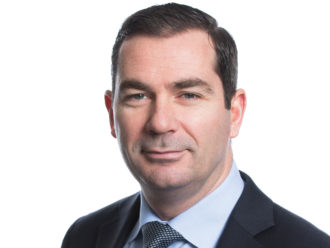You joined Nest from USS. Was that a big cultural shift?
I joined Nest at the end 2020, so I have just hit my 18 month anniversary. It is a different set up, and not just because I moved from defined benefit (DB) to defined contribution (DC).
At USS, we managed the assets in-house, while Nest is fully outsourced. That is quite a change in terms of team size and roles. The dynamic is very different.
At USS I managed listed equities, but within a maturing DB scheme you are fighting to stand still, in absolute assets under management (AUM) terms as the scheme is de-risking into fixed income securities and selling equities.
In contrast, Nest has a positive cashflow coming in all the time. It’s also quite nice after 20 years of running money to not be constantly on Bloomberg watching the markets or reading statements at seven in the morning because you need to know what is happening in your portfolio. It’s nice to step back from that.
When I joined USS, it had a small team and with a small team you have to roll your sleeves up and get on with it. So I have covered pretty much every asset class to a greater or lesser extent over my career. For example, I once had to cover for the bond manager when she was on maternity leave because back then we only had one bond manager.
That’s hard to imagine now.
Yes, and the fixed income team is much bigger now but back then it broadly involved me watching a screen and telling the chief investment officer if yields reached a certain level so that he could put an order into the market for execution.
That was going on alongside my European equity day job. I also worked on USS’ first private market deals, so I have had fingers in many pies over the years.
You joined Nest as head of long-term investment strategy. What did that entail?
My core role is looking at the long-term risks and opportunities that underlie our asset allocations. It is trying to identify when the tide is changing and that is what we should be reacting to.
We do not react to every wave in the sea, that would be too short term. But if the tide changes, then we jolly well ought to be positioned for that.
What long-term investment trends are you looking at?
We did a piece of work earlier this year on how asset allocations would need to change if we were in a sustained higher or more volatile inflationary environment.
It looked at what happens to asset class correlations during such a period compared to the one we have been in for the past 20 years. We have also been thinking about our investment objectives, about what we are trying to achieve and how our assets should be allocated to deliver that.
We have looked at central bank digital currencies, too. There is nothing we can do with that right now, but it is interesting to look at what it could mean for the financial services industry.
Are we on the brink of the tide changing?
We could be. After the global financial crisis, we had monetary policy without fiscal policy. This changed during Covid, when we had both working together.
That turbocharged the economy probably a bit too much. In the UK, we also have the disruptions caused by Brexit which are muddying the water.
My view is that central banks do not want to return to the environment we saw post-financial crisis where they struggled to get inflation up to 2%. They can’t leave it at 10% but would settle for 3% or 4%.
You are implying that central banks can control inflation. What do you think of the view that this is beyond their control?
Monetary policy should not respond to supply shocks because it does not solve such problems. What is interesting is that although wages are going up, particularly among low-skilled workers in the US, we are not seeing wage growth in real terms. There is no evidence yet that the wage-price spiral everyone seems to be worried about is happening.
It will be interesting to see what happens when the German unions start doing their settlements. The way the furloughing scheme worked in Germany meant there was not a great resignation and subsequent mass search for new jobs. What the unions negotiate will set the terms for the rest of continental Europe.
You mentioned changes to the correlation of asset classes. With bond and equity performance increasingly positively correlated, are you including other asset classes to ensure diversification?
Our focus in the past few years has been on opening up private markets and illiquids. Nest now has access to property, private credit, private equity and unlisted infrastructure. We have all the main tools we need to achieve the level of diversification we want. Our aim is to have a fifth of our portfolio in private markets in the coming years.
Last year you predicted emerging markets were equipped to outperform coming out of the pandemic. What do you think now, given the strength of the dollar?
A stronger US dollar and slower global growth are a headwind to emerging markets. We are beginning to see challenges with many emerging market countries in default or debt distress. We do not see this as a major liquidity event, or that this default wave will impact stronger emerging markets.
Emerging markets remain a fundamental part of the portfolio and should benefit from higher growth rates over the medium term. Research tends to show that they are relative beneficiaries in a higher global inflation environment. But to increase our exposure to emerging markets we will need to be compensated for the increased risks – we are monitoring the situation carefully.
How does the financial impact of climate change tie into these long-term trends?
Climate change is one of the biggest risks facing society and the impacts from the transition to low-carbon economies will likely be significant. If not managed carefully and proactively, climate change could reduce investment returns for our members.
But we also believe climate change presents an opportunity if we target assets which should only become more desirable, such as renewable energy infrastructure and companies well-positioned to succeed in low-carbon economies.
More and more DC schemes are investing in private markets as the need for daily liquidity is being questioned. If market volatility continues, could requests for withdrawals from DC members increase?
We have not seen any evidence of that. Surveys of our members suggest that they will react to market stress, but that hasn’t happened in practice. This could change when the pensions dashboard arrives and people have the information on fund valuation to hand.
For most schemes, where the payroll runs on a single day, you know when the cash is coming in and you can plan ahead so you do not need daily liquidity. We have cash coming in every day of the week, which creates a challenge.
A privileged position to be in?
It is, but we want to put the money to work as soon as possible. The alternative would be having a dealing day once a week so we would only need to price weekly.
But then some poor person’s cash just sits there for a week, which is not great. With hindsight, defined contribution should not have been set up with daily pricing. But we are where we are and going back is quite difficult.
Could the requirement for daily pricing in DC be abandoned at some point?
I think we will always have it. We have to ensure that we are giving people a fair price for the contributions they make. But I do not believe that the need for daily pricing and illiquids are entirely incompatible. The two can sit next to each other, you just need to balance it.
We have done some modelling on the level of illiquid assets we can hold, even for retirees. We do not hold illiquids, except for listed property in our post retirement funds currently, but we could also put listed infrastructure or short-dated private credit in those funds.
Even at 67, someone has the potential to save for another 10 to 15 years, so sticking them completely in government bonds and cash is not a good way to achieve that. Of course, you need to do it cautiously, which we could do because of our cashflows.
The main issue is to avoid being a forced seller. We need to find a level where we can recycle assets between generations so everyone can benefit.
You are not the only scheme looking into this. The Royal Mail’s retirement plan is too.
And USS is already doing it. Their idea is that if the DC scheme needed to sell certain assets the DB scheme might like to buy them. So the DB scheme could provide liquidity to the DC one.
You don’t have a DB scheme to sell assets to, so couldn’t the retirement stage default fund transfer less-liquid assets to the growth-oriented default fund and vice versa?
We are a scheme which needs to invest around £400m of member contributions a month. We, therefore, do not need to sell assets on the open market. We already transfer assets across Nest’s target date funds, minimising transaction costs.
Nest is considering how to best incorporate illiquids into the lifecycle of our members. If we invest our members in infrastructure and private equity early in their savings journey, when they can be most patient, we can maximise the compounding bene t generated from holding these assets for the long term.
We have cash coming into all stages of the product, apart from post retirement, so we can match the incoming cashflow with potential sales of assets. We rarely have days where we have net outflows.
You have £477m of cash coming in each month. It must be quite a challenge to deploy that.
The efficient portfolio mandate was created to prevent us from sitting on large amounts of cash, cash which is not earning a return while waiting to be invested. Using that efficient portfolio mandate, we can equitise the cash whilst it is waiting to be put into real infrastructure, private equity or another strategy, so that helps.
What can schemes do to avoid being a forced seller?
This was certainly a lesson from the global financial crisis, when a lot of smaller endowments found themselves in trouble when the value of listed assets fell while private ones did not.
You suddenly have a lot of capital committed to private funds which you have to honour if they call it for new investments but you have no cash, so you end up having to sell more of your liquid assets at depressed prices.
That can become a negative spiral if you do not manage it well.
LIZ FERNANDO’S CV
December 2021 – Present
Nest
Deputy chief investment officer
November 2020 – December 2021
Nest
Head of long-term investment strategy
August 2012 – September 2020
USS
Head of equities
January 2006 – August 2012
USS
Deputy chief investment officer, head of European equities
Managing capital flows
Managing cash inflows has been a key issue for the master trust. Over the past year, Nest received on average £477m in contributions a month, which helped grow its assets to £24bn from £17bn.
With one in three workers in Britain saving into a Nest pension, the master trust expects to manage more than £100bn in assets by the end of the next decade.
To manage these inflows, Nest launched an efficient portfolio management mandate in May, selecting Amundi to provide derivatives contracts to rebalance Nest’s target allocations more efficiently.
It will also help Nest equitise cash set aside for private market deployment. Nest has not committed an amount of money to the mandate, preferring to use derivatives to respond to specific market circumstances.





Comments